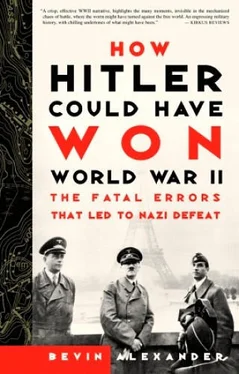A number of mistakes occurred. Patton attacked Metz and Nancy, when they should have been bypassed, and his forces should have swung north to Luxembourg and Bitburg, where there were few Germans. This, General Günther Blumentritt reported, would have resulted in the collapse of German forces on the front.
Montgomery’s greatest single failure was his pause from September 4 to 7 after reaching Brussels and Antwerp, giving German paratroopers just enough time to organize a defense. The fault, wrote John North, official historian of the 21st Army Group, was a “war-is-won” attitude. Little sense of urgency prevailed among commanders during a vital two-week period in mid-September, and among the troops there was a strong inclination to go slow and avoid being killed.
Montgomery’s lack of drive at this critical point illustrates that the best chance to finish the war quickly was lost when Patton’s gasoline was shut off at the end of August, and he was a hundred miles closer to the Rhine than the British. He, far more than Montgomery, was capable of exploiting opportunity. Yet, as Westphal pointed out, a breakthrough almost anywhere still could have succeeded till mid-October, and neither Patton, Bradley, nor Montgomery saw it.
Meanwhile on the eastern front, the Germans had experienced nothing but disaster. By January 1944, the Red Army had twice the men and tanks as the German army. The only possibility for Germany to avoid total defeat was immediate withdrawal to the 1941 frontier and construction of a deep mine-strewn defensive line studded with antitank guns, advocated by Erwin Rommel. Heinz Guderian and Erich von Manstein recommended a similar approach, but Adolf Hitler rejected any retreat not actually forced on him by the Red Army, and on March 30 ousted Manstein. Consequently, throughout 1944, German forces in the east conducted one pointless defensive stand and one retreat after another.
By the end of the year, the Soviets were on the Vistula River opposite Warsaw, had surrounded Budapest, driven the Germans out of southeastern Europe and all but a small part of the Baltic states, and forced Finland, Romania, Bulgaria, and Hungary out of the war. The Germans had lost a million men. As 1945 began, the Soviets were poised for the final assault on the Third Reich.
23 THE BATTLE OF THE BULGE

ON SEPTEMBER 16, 1944, AS WESTERN ALLIED FORCES WERE CLOSING AGAINST the West Wall or Siegfried line, Adolf Hitler met with his closest military advisers at his Wolfsschanze— Wolf’s Lair—in East Prussia.
Alfred Jodl, Hitler’s operations chief, reported that German troops withdrawing from southern France were forming a new line in the Vosges Mountains and on old forts in northeastern France. Other Germans were building new lines in Holland or falling back from Belgium into the West Wall.
There was one place of special concern: the mountainous, heavily forested Ardennes of eastern Belgium and northern Luxembourg. Here Americans were attacking, and the Germans had almost nothing to deter them.
Hitler sat erect and ordered Jodl to stop. After a long pause, Hitler announced: “I have made a momentous decision. I shall go over to the offensive, that is to say here, out of the Ardennes, with the objective Antwerp.”
The Ardennes: the same region through which Hitler had sent his panzers in 1940, and had defeated France and thrown the British off the Continent in six weeks. The French and British hadn’t thought the blow would come through there in 1940. Perhaps the Americans would be equally blind in 1944.
With this decision, made at the nadir of German fortunes in the west, Adolf Hitler set in motion a campaign that was a stunning surprise to Allied commanders, on a scale beyond their imagination. It was to be the greatest battle ever fought by Americans, involving more than a million men, precipitating a supreme crisis, and demonstrating the most telling failure in history of American military intelligence.
Hitler reasoned that a swift and overwhelming strike at Antwerp, a hundred air miles away, would cut off the British and Canadian armies in the Netherlands. This would compel them to surrender, ending Britain’s participation in the war. The U.S. 1st and 9th Armies, also north of the Ardennes, would be trapped as well. The United States, left with half its army in Europe and fearful of Communist hordes sweeping in from the Soviet Union, might conclude a separate peace. Hitler then could turn all his resources against the Russians, and stop their advance. Hitler and the Nazi regime would survive.
It was a desperation move, betting everything on a single throw of the dice. Yet if Adolf Hitler continued on his present course, he and his regime would perish in short order. He had just enough strength left to make one final effort to alter the balance of power.
Hitler had faith that chance could bring fortuitous circumstances. His greatest hero was Frederick the Great of Prussia, who had held on against impossible odds in the Seven Years War 1757–1763 until the empress of Russia died and the coalition against him evaporated. If Hitler could seize Antwerp and destroy four British, Canadian, and American armies, it could happen again.
Hitler was already planning for the offensive on September 1, when he called Field Marshal Gerd von Rundstedt, stiff, formal and seventy years old, to his headquarters and asked him to return as commander in chief west. Rundstedt, as Charles MacDonald wrote, “was to most Germans the paragon of all that was good and right about the German officers corps.” Hitler disliked him intensely, in part because he represented the class and elegance that Hitler lacked, and in part because, in private, he referred to Hitler as “the Corporal,” the Fuehrer’s rank in World War I.
Hitler needed a figurehead around whom Germans could rally, and Rundstedt, true to his soldier’s creed of loyalty, agreed to serve. Hitler didn’t tell Rundstedt what he had in mind. The field marshal was to defend in front of the West Wall as long as possible, then fall back on it. Everything depended on this defense, Hitler stressed. There was insufficient strength to strike offensively.
Having lied to his commander, Hitler ordered his propaganda chief,
Joseph Goebbels, to find somewhere the manpower to create fifteen new divisions with a new name, Volksgrenadier, and reinforce thirty-five existing ones. Goebbels did so: seventeen-year-olds, men in their mid-forties, transfers from the navy, Luftwaffe, and rear services, drafts from garrisons in Scandinavia. Hitler withdrew four SS panzer divisions from the line in the west to be refitted, and created a new headquarters, 6th Panzer Army, commanded by Josef (Sepp) Dietrich, an old crony, a bullish former butcher and sergeant in the First World War. Dietrich was hard driving, had little education, and relied on a brilliant assistant, Fritz Kraemer, for military advice.
On the Allied side, there was no idea whatsoever of a threat through the Ardennes. Troy Middleton’s 8th Corps was covering an eighty-mile stretch, most of the region. Two of his four divisions were raw and new, two recuperating from heavy losses in battles elsewhere. Talking with Middleton, Omar Bradley said: “Even if the German were to bust through all the way to the Meuse, he wouldn’t find a thing in the Ardennes to make it worth his while.”
Eisenhower and Bradley were more concerned with the failure of an offensive Bradley had undertaken to smash through to the Rhine, then swing north and encircle the Ruhr. Patton’s 3rd Army was to drive through the Saar to Frankfurt, while, north of the Ardennes, Courtney Hodges’s 1st Army and the new 9th Army under William Simpson were to thrust eastward from Aachen to Cologne and Bonn. Patton gained Metz on December 13, but was stopped cold at the Siegfried line short of the Saar. In the effort, Patton’s army lost 27,000 men.
Читать дальше



![Джонатан Димблби - Barbarossa - How Hitler Lost the War [calibre]](/books/385421/dzhonatan-dimblbi-barbarossa-how-hitler-lost-the-w-thumb.webp)









